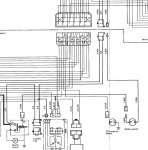The tractor I am dealing with is a 1990 L2850 Kubota. I originally thought I had a relay issue, but after getting a wiring schematic I do not see a starter relay. The issue is a voltage drop to the starter from the key. I am only getting 9 volts. I see where the key wire to the starter solenoid is labeled as "2-BW and stays that way on both sides of the safety switch. It changes to 2-BR and continues to the key switch.
I cannot see anywhere that the voltage would be dropped. I will be pulling the switch and taking a reading at the main post and the starter connection.
Can anyone think of anything else?
BR
I cannot see anywhere that the voltage would be dropped. I will be pulling the switch and taking a reading at the main post and the starter connection.
Can anyone think of anything else?
BR
Attachments
-
17.2 KB Views: 217
-
89.7 KB Views: 290



